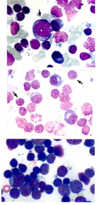Leukaemia and Lymphadenopathy Flashcards
What is leukaemia?
A neoplastic condition of the bone marrow in which neoplastic cells of lymphoid or non-lymphoid stem cells or their progeny undergo clonal expansion with or without cellular differentiation
What are the clinical signs of leukaemia due to?
–Failure of normal marrow function
–Infiltrated organ dysfunction
–Hyperviscosity
–Paraneoplastic syndromes (IMHA, hypercalcaemia)
What is the classification for acute leukaemia?
- Neoplastic transformation during stem cell proliferation
- Large numbers of immature (undifferentiated) cells
- Aggressive rapid disease
- Cytopenia is very common
–Marrow disruption by neoplastic expansion
What is characteristic of chronic leukaemia?
- Neoplastic transformation following differentiation
- Giving rise to large numbers of mature (differentiated) cells
- Slow progression and less aggressive in comparison to acute disease
- Cytopenia is rare
Define cytopenia?
•When there is marrow disruption, lineage kinetics result in disappearance of neutrophils first, then platelets then RBC’s
Which of the following has A) the least duration of marrow disruption and B) the most?
A) Neutrophil
B) RBC
What are the 2 forms of acute leukaemia?
- ALL (acute lymphoid leukaemia)
- AML (acute myeloid leukaemia)
Lymphoma involving BM:
A) How many blast cells in marrow?
B) What is the circulating blast count?
C) What is the cytopenia like?
D) What is the lymphadenopathy like?
E) Is there systemic illness?
A) <40%
B) Low
C) Mild or absent
D) Massive
E) May not be
Acute lymphoblastic leukaemia:
A) How many blast cells in marrow?
B) What is the circulating blast count?
C) What is the cytopenia like?
D) What is the lymphadenopathy like?
E) Is there systemic illness?
A) > 40%
B) High
C) Severe
D) Mild to moderate
E) Usually
What is acute leukaemia and how do we identify?
–Neoplastic transformation during stem cell proliferation, large numbers of immature (undifferentiated) cells
–Identification of lineage by microscopic morphology difficult and often wrong
How can we look at Acute leukaemia morphology?
- Immunophenotyping
- Clonality testing (PARR)
What is immunophenotyping?
–Immuno-cytology/histology of marrow aspirates or biopsies
–Immuno-labelled flow cytometry of EDTA blood or marrow
What is PARR?
•PCR for antigen receptor rearrangements
What is this?

Chronic leukaemia morphology
What is this?

Acute leukaemia morphology
What can cause lymphadenopathy?
- Reactive hyperplasia
- Lymphadenitis
- Metastatic neoplasia
- Lymphoma
What drugs might affect lymph node FNA/CS?
Steroids
What is in each of these FNA samples?

Top - lymphoblast
Middle - macrophages
Bottom - plasma cell
What is this?

Reactive hyperplasia
What is seen in reactive hyperplasia?
- Heterogeneous cell pop
- 75-95% small
- Low %age medium and large cells (up to 15% in reactive)
- Occ plasma cells
- Occ macrophages (>2% in reactive)
- V few neutrophils, eosinophils, mast cells
What is this?

Lymphadenitis
What is seen in Lymphadenitis?
- Increased neutrophils (>5%) or eosinophils (>3%)
- Macrophages (>3%)
–Incl epithelioid and multinucleate giant cells in granulomatous inflammation
- Inflammatory cells may be mildly increased or completely replace normal structure
- Drained pathology
–Eosinophilic – allergic
–Granulomatous or pyogranulomatous – fungal and protozoal
What is this?

Metastatic neoplasia
What can cause metastatic neoplasia?
- Carcinoma cells
- Myeloproliferative disorders
- Mast cells (>3%)
- Melanoma cells
What is this?

Lymphoma
What is seen in lymphoma? What is required to diagnose?
•Increased %age of large immature lymphocytes
–Confident at >50%
- More mitoses than reactive
- More tingible body macrophages
- More lymphoglandular bodies (cell fragility – not pathognomic)
- Histology usu required
Reactive of neoplastic?

Reactive hyperplasia
Neoplastic or reactive?

Neoplastic


